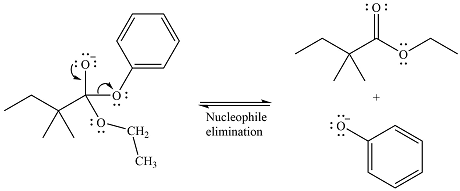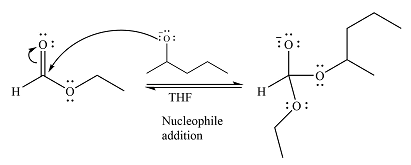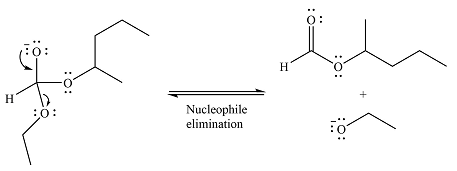
(a)
Interpretation:
The detailed mechanism and the major product of the given reaction is to be drawn.
Concept introduction:
The carbonyl carbon atom in compounds such as
Answer to Problem 20.1P
The mechanism of the given reaction can be drawn as

The major product of the reaction is

Explanation of Solution
The given reaction is

The carbonyl carbon in the ester substrate is partially positively charged, i.e., electron-poor. The reagent

In the next step, the leaving group, the phenoxy ion, from the original ester is eliminated. This step forms the major product, another ester.

Since the substrate and the product are both esters, of comparable stability, the two steps are reversible.
Thus, the complete detailed mechanism for the reaction can be drawn as

And the major product of the reaction is

The mechanism of the reaction and the major product were drawn based on nucleophilic addition-elimination step.
(b)
Interpretation:
The detailed mechanism of the reaction and its major product are to be drawn.
Concept introduction:
The carbonyl carbon atom in compounds such as aldehydes, ketones, and esters is relatively electron-poor. It can add a nucleophile, forming a tetrahedral transition state. This is followed by the elimination of the leaving group, itself a nucleophile, to form the product. When an ester is treated with an alkoxide, it replaces the original alkoxide group in from the ester substrate. Since the reaction results in formation of another ester, it is known as transesterification.
Answer to Problem 20.1P
The complete mechanism for the reaction can be drawn as

And the major product of the reaction as

Explanation of Solution
The given reaction is

The substrate is an ester, with an electron-poor carbonyl carbon. The reagent is ionic and essentially acts as the negativey charged nucleophile

Next, the leaving group (ethoxide) from the original ester is eliminated to formt eh major product.

The major product is another ester, of comparable stability. Therefore, both steps will be reversible steps.
Thus, the complete mechanism for the reaction can be drawn as

And the major product of the reaction as

The complete mechanism and the major product of the reaction were drawn based on nucleophilic addition-elimination steps.
Want to see more full solutions like this?
Chapter 20 Solutions
EBK ORGANIC CHEMISTRY: PRINCIPLES AND M
- Draw the Fischer projection from the skeletal structure shown below. HO OH OH OH OH H Q Drawing Atoms, Bonds and Rings Charges I ☐ T HO H H OH HO I CH2OH H OH Drag H OH -CH2OH CHO -COOH Undo Reset Remove Donearrow_forwardplease provide the structure for this problem, thank youarrow_forwardpresented by Morallen Lig Intermine the hand product for the given mution by adding atoms, bonds, nonhonding diarion panda скуль Step 3: Comp the draw the product Step 2: Agama workup Compithe 429 ملولةarrow_forward
- Reaction A 0,0arrow_forwardpresented by Morillon Leaning Predict the organic product for the min кусур HSC Adithane carved arnown to come than that to the condon slchroruis in acid in in aquishri with ноюarrow_forward6.15PM Sun Mar 30 K Draw the major product of this reaction. Include any relevant stereochemistry. Ignore inorganic byproducts. Problem 1 of O H [PhзPCH2CH3]*C|¯ NaH Drawing > Q Atoms, Bonds and Draw or tap a nearrow_forward
- 8:17 PM Sun Mar 30 Draw the major product of this reaction. Ignore inorganic byproducts. HSCH2CH2CH2SH, BF3 Probler Drawing Ato Bonds Clarrow_forwardpresented by Mr L How the coprion. (Il Done in no wraction, dew the starting redential) доarrow_forward8:16 PM Sun Mar 30 K Draw the major product of this reaction. Ignore inorganic byproducts. Proble 1. CH3MgBr 2. H3O+ F Drawingarrow_forward
- о но оarrow_forwardName the major organic product of the following action of 4-chloro-4-methyl-1-pentanol in neutral pollution 10+ Now the product. The product has a molecular formula f b. In a singly hain, the starting, material again converts into a secule with the molecular kormula CIO. but with comply Draw the major organic structure inhalationarrow_forwardMacmillan Learning Alcohols can be oxidized by chromic acid derivatives. One such reagent is pyridinium chlorochromate, (C,H,NH*)(CICTO3), commonly known as PCC. Draw the proposed (neutral) intermediate and the organic product in the oxidation of 1-butanol by PCC when carried out in an anhydrous solvent such as CH₂C₁₂. PCC Intermediate OH CH2Cl2 Draw the intermediate. Select Draw Templates More с H Cr о Product Draw the product. Erase Select Draw Templates More H о Erasearrow_forward
 ChemistryChemistryISBN:9781305957404Author:Steven S. Zumdahl, Susan A. Zumdahl, Donald J. DeCostePublisher:Cengage Learning
ChemistryChemistryISBN:9781305957404Author:Steven S. Zumdahl, Susan A. Zumdahl, Donald J. DeCostePublisher:Cengage Learning ChemistryChemistryISBN:9781259911156Author:Raymond Chang Dr., Jason Overby ProfessorPublisher:McGraw-Hill Education
ChemistryChemistryISBN:9781259911156Author:Raymond Chang Dr., Jason Overby ProfessorPublisher:McGraw-Hill Education Principles of Instrumental AnalysisChemistryISBN:9781305577213Author:Douglas A. Skoog, F. James Holler, Stanley R. CrouchPublisher:Cengage Learning
Principles of Instrumental AnalysisChemistryISBN:9781305577213Author:Douglas A. Skoog, F. James Holler, Stanley R. CrouchPublisher:Cengage Learning Organic ChemistryChemistryISBN:9780078021558Author:Janice Gorzynski Smith Dr.Publisher:McGraw-Hill Education
Organic ChemistryChemistryISBN:9780078021558Author:Janice Gorzynski Smith Dr.Publisher:McGraw-Hill Education Chemistry: Principles and ReactionsChemistryISBN:9781305079373Author:William L. Masterton, Cecile N. HurleyPublisher:Cengage Learning
Chemistry: Principles and ReactionsChemistryISBN:9781305079373Author:William L. Masterton, Cecile N. HurleyPublisher:Cengage Learning Elementary Principles of Chemical Processes, Bind...ChemistryISBN:9781118431221Author:Richard M. Felder, Ronald W. Rousseau, Lisa G. BullardPublisher:WILEY
Elementary Principles of Chemical Processes, Bind...ChemistryISBN:9781118431221Author:Richard M. Felder, Ronald W. Rousseau, Lisa G. BullardPublisher:WILEY





